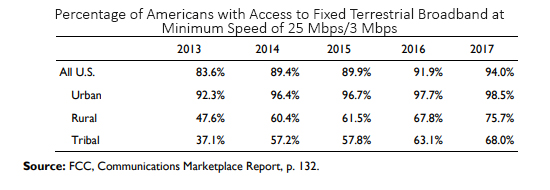 A new Congressional Research Service Report offers a wealth of information about the state of broadband deployment and adoption, along with summarizing current broadband federal assistance programs. The report, titled “Broadband Internet Access and the Digital Divide: Federal Assistance Programs,” even lists dozens of broadband-related bills introduced in the 115th Congress, even though they didn’t pass.
A new Congressional Research Service Report offers a wealth of information about the state of broadband deployment and adoption, along with summarizing current broadband federal assistance programs. The report, titled “Broadband Internet Access and the Digital Divide: Federal Assistance Programs,” even lists dozens of broadband-related bills introduced in the 115th Congress, even though they didn’t pass.
The authors seem to have been tightly focused on simply presenting the facts, leaving it to readers to draw their own conclusions about the information presented – a refreshing departure from what we see so often in this highly partisan era.
Broadband Mapping Issues
I found some information in the report related to a topic Telecompetitor has been following closely – concerns about the accuracy of the FCC’s broadband deployment data, which considers an entire census block to have broadband, even if only one household in that block can actually get service. We reported last year that a proposed federal budget allocated $7.5 million to redo the national broadband map with the goal of addressing those deficiencies. The new report confirms that was the number ultimately adopted and that an additional $7.5 million has been proposed for fiscal year 2019.
Interestingly, a different section of the 36-page report also notes another broadband map-related fact that Telecompetitor has reported on. In a section about the broadband stimulus program included in the American Recovery and Reinvestment Act of 2009, the authors note that the act directed $350 million in funding to develop and maintain a broadband inventory map. The amount ultimately spent on that program was $293 million, according to a 2016 report.
In keeping with the authors’ “just the facts” approach, however, the report didn’t ask a question we did: If $293 million was spent to create a national broadband map circa 2015 but didn’t include a method of keeping that information current, yet we are allocating only $7.5 million per fiscal year to fix the problem, the facts suggest one of two things or a combination of the two: either we spent too much on mapping through the stimulus program or we’re not allocating enough funding today or both.
It’s much more than an academic question because federal broadband availability data is critical in targeting funding for broadband federal assistance programs.
Broadband Federal Assistance Programs
The broadband federal assistance program report includes some useful charts, such as this one summarizing the percentage of Americans with access to fixed terrestrial broadband at minimum speeds of 25 Mbps downstream and 3 Mbps upstream between 2013 and 2017, broken down between urban and rural areas:

Other useful information included in the broadband federal assistance program report:
- A breakdown of the Universal Service Fund budget by program (including high-cost, schools and libraries, rural telehealth and low-income), including caps, where appropriate
- A list of studies that have attempted to assess the economic impact of broadband and their findings
- The aforementioned list of broadband legislation, which includes a brief summary of what each bill proposed to do

